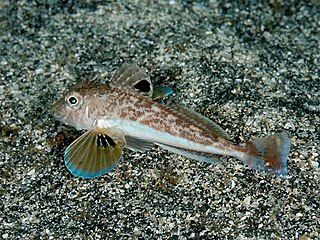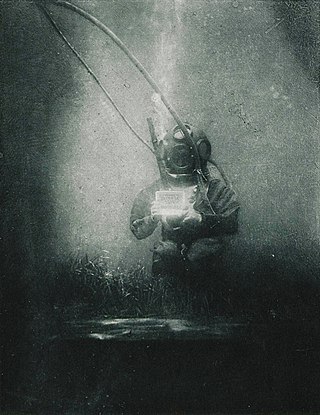Victor Gruschka Springer was an American biologist who was a Senior Scientist emeritus, Division of Fishes at the Smithsonian Institution's National Museum of Natural History in Washington, D.C. He was a specialist in the anatomy, classification, and distribution of fishes, with a special interest in tropical marine shorefishes. He published numerous scientific studies on these subjects; also, a popular book called "Sharks in Question, the Smithsonian Answer Book" 1989.

Sillago is a genus of fish in the family Sillaginidae and the only non-monotypic genus in the family. Distinguishing the species can be difficult, with many similar in appearance and colour, forcing the use of swim bladder morphology as a definitive feature. All species are benthic in nature and generally coastal fish, living in shallow, protected waters although there are exceptions. Minor fisheries exist around various species of Sillago, making them of minor importance in most of their range. This genus has the widest distribution of any smelt-whiting genus, spanning much of the Indo-Pacific. The genus ranges from the east coast of Africa to Japan in the east and Southern Australia in the south, with most species concentrated around South East Asia, the Indonesian Archipelago and Australia. Many species have overlapping distribution, often making positive identification hard.
George Sprague Myers was an American ichthyologist who spent most of his career at Stanford University. He served as the editor of Stanford Ichthyological Bulletin as well as president of the American Society of Ichthyologists and Herpetologists. Myers was also head of the Division of Fishes at the United States National Museum, and held a position as an ichthyologist for the United States Fish and Wildlife Service. He was also an advisor in fisheries and ichthyology to the Brazilian Government.

Boutan's whiting is a poorly understood species of coastal marine fish of the smelt-whiting family Sillaginidae that inhabits the waters of the Gulf of Tonkin and south eastern China. Like most sillaginids, the species inhabits areas populated with a number of other whiting species of similar appearance, causing the species to often be misidentified as the well known Sillago sihama, and for this reason its biology is poorly known. The species is taken by seine net in Vietnam and is often exported to Japan.
Maurice Kottelat is a Swiss ichthyologist specializing in Eurasian freshwater fishes.

The rough whiting is a dubious species of coastal marine fish in the smelt-whiting family Sillaginidae. The species is known only from the holotype which was collected in 1941 on the south coast of Papua New Guinea, but is thought to be lost. S. nierstraszi is currently a valid species, although during his revision of the sillaginids, Roland McKay suggested the species to be a senior synonym of Sillago analis.

The estuarine whiting, also known as Vincent's whiting, is a species of benthic inshore marine fish of the smelt-whiting family, Sillaginidae. The estuarine whiting is very similar in appearance to the northern whiting, Sillago sihama, and as such was mistaken for the latter until 1980, when R.J. McKay identified the species based primarily on swimbladder morphology. The estuarine whiting is distributed along both the east and west coasts of India, primarily inhabiting the muddy substrates of estuaries. The species is locally important to fisheries in India, and is recognized as having aquaculture potential.
Enneapterygius shaoi is a species of triplefin blenny in the genus Enneapterygius. It was described by Chiang Min-Chia and Chen I-Shiung in 2008. The specific name honours the ichthyologist and marine ecologist Kwang-Tsao Shao of the Biodiversity Research Center at the Academia Sinica in Taiwan. It occurs off the eastern and southern coast of Taiwan.
Gerald Robert "Gerry" Allen is an American-born Australian ichthyologist. His career began in 1963, when he spent a semester at the University of Hawaii, where he also received a PhD in marine zoology in 1971. In 1972, Allen wrote his doctoral thesis on the systematics and biology of the anemone fish.

Lepidotrigla kishinouyi, the devil sea robin, is a species of marine, demersal ray-finned fish from the family Triglidae, the gurnards and sea robins. It is found in the northwestern Pacific Ocean.

Hugo Frederik Nierstrasz was a Dutch zoologist, known for his research in the fields of malacology and carcinology.

Louis Marie-Auguste Boutan was a French biologist and photographer. He was a pioneer in the field of underwater photography.

Lopholatilus villarii, the tilefish, is a species of marine ray-finned fish, a tilefish belonging to the family Malacanthidae. It is native to the western South Atlantic Ocean off the coasts of Brazil, Uruguay and Argentina. This species was first formally described in 1915 by the Brazilian naturalist Alpilio de Miranda Ribeiro (1874-1939) with the type locality given as Praca do Mercado, Brazil. The specific name honours the Brazilian naval captain Frederico Otávio de Lemos Villar (1875-1964) who participated in fisheries research off Brazil.
Ophichthus shaoi, the long-bodied snake eel, is an eel in the family Ophichthidae. It is found around Taiwan. This species reaches a length of 62.3 cm (24.5 in).
Branchiostegus paxtoni, or Paxton's tilefish, is a species of marine ray-finned fish, a tilefish belonging to the family Malacanthidae. It is found in the Eastern Indian Ocean and is known only from a locality 190 km northwest of Port Hedland, Western Australia. This species reaches a length of 25.5 cm (10.0 in).
Branchiostegus gloerfelti, the Australian tilefish, is a species of marine ray-finned fish, a tilefish belonging to the family Malacanthidae. So far it has only been found in the southwest Sumatra to Bali Strait in Indonesia. This species reaches a length of 25.5 cm (10.0 in).

Branchiostegus wardi, or Ward's tilefish, is a species of marine ray-finned fish, a tilefish belonging to the family Malacanthidae. It is found from Australia to New Caledonia and Papua New Guinea. This species reaches a length of 40 cm (16 in).
Parapercis shaoi is a ray-finned fish species in the sandperch family, Pinguipedidae. It is found in Taiwan. This species reaches a length of 15.3 cm (6.0 in).
Parapercis moki, also known as Mok's sandperch, is a species of [[ray-finned fish]0 in the sandperch family, Pinguipedidae. It is found in the north-western Pacific Ocean off Taiwan.

The black-banded sillago is a species of marine ray-finned fish belonging to the family Sillaginidae, the smelt-whitings or sillagos. This species is found in the western Pacific Ocean.









